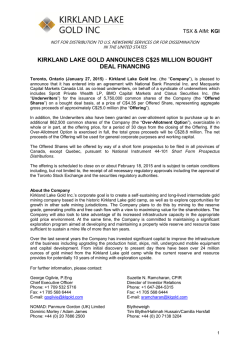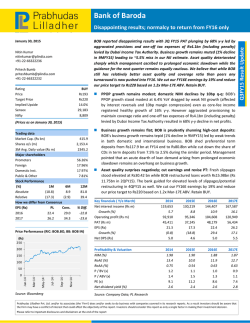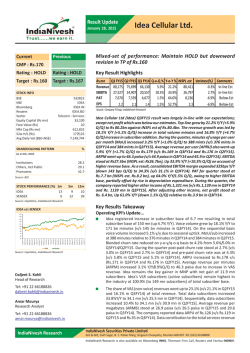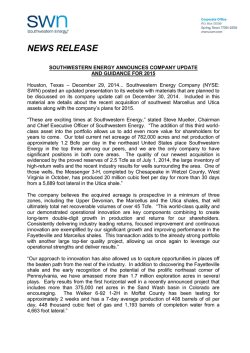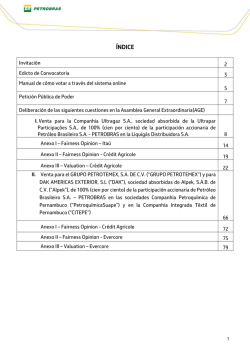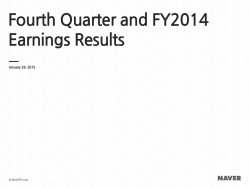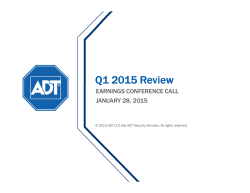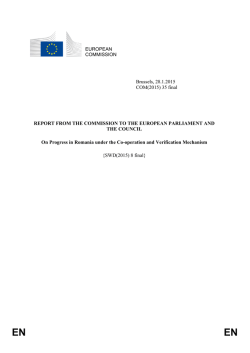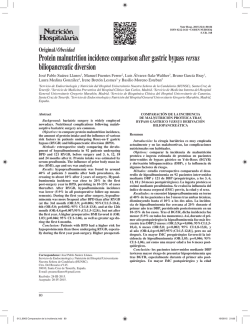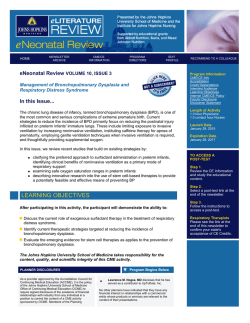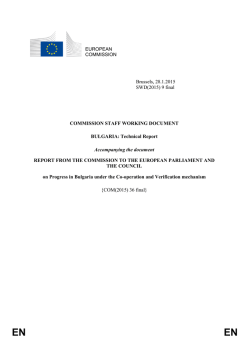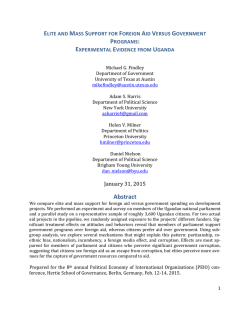
Webcast - 3T14 - RI - Inglês - FINAL - Petrobras-RI
NON REVIEWED INFORMATION 3rd Quarter 2014 __ Conference Call / Webcast January 29th 2015 1 DISCLAIMER FORWARD-LOOKING STATEMENTS: DISCLAIMER This presentation includes forward-looking statements within the meaning of Section 27A of the Securities Act of 1933, as amended, and Section 21E of the Securities Exchange Act of 1934, as amended, that are subject to risks and uncertainties. The forward-looking statements, which address the Company’s expected business and financial performance, among other matters, contain words such as “believe,” “expect,” “estimate,” “anticipate,” “optimistic,” “intend,” “plan,” “aim,” “will,” “may,” “should,” “could,” “would,” “likely,” and similar expressions. Readers are cautioned not to place undue reliance on these forward-looking statements, which speak only as of the date on which they are made. There is no assurance that the expected events, trends or results will actually occur. We undertake no obligation to publicly update or revise any forward-looking statements, whether as a result of new information or future events or for any other reason. The Company’s actual results could differ materially from those expressed or forecast in any forward-looking statements as a result of a variety of assumptions and factors. These factors include, but are not limited to, the following: (i) failure to comply with laws or regulations, including fraudulent activity, corruption, and bribery; (ii) the outcome of ongoing corruption investigations and any new facts or information that may arise in relation to the “Lava Jato Operation”; (iii) the effectiveness of the Company’s risk management policies and procedures, including operational risk; and (iv) litigation, such as class actions or proceedings brought by governmental and regulatory agencies. A description of other factors can be found in the Company’s Annual Report on Form 20-F for the year ended December 31, 2013, and the Company’s other filings with the U.S. Securities and Exchange Commission. NON-SEC COMPLIANT OIL AND GAS RESERVES: CAUTIONARY STATEMENT FOR US INVESTORS We present certain data in this presentation, such as oil and gas resources, that we are not permitted to present in documents filed with the United States Securities and Exchange Commission (SEC) under new Subpart 1200 to Regulation S-K because such terms do not qualify as proved, probable or possible reserves under Rule 4-10(a) of Regulation S-X. 2 Background: Lava Jato Operation and Investigations “Lava Jato Operation” conducted by the Federal Police Mar/14 Oct/14 Need to postpone the release of the Financial Statements Nov/14 Dec/14 “Lava Jato Operation” reached Petrobras in March 2014 through the arrest of the company’s former Downstream Director, Paulo Roberto Costa, on charges of corruption, embezzlement, among other offenses. When the Company filed its 2013 and first half 2014 annual financial statements, there was no evidence available that would have affected the conclusions of the Company or the independent auditors regarding the financial statements; Beginning on October 8, 2014, depositions of former Director, Paulo Roberto Costa, and other investigation targets were made public, mentioning “cartelization”, “exceeding prices” and “bribery”. With these investigations, Petrobras was not able to release the reviewed 3Q14 financial statements, due to the time needed to: gain greater understanding from the ongoing internal investigations led by independent law firms; make any necessary adjustments to the financial statements. 3 Need to Rectify the Error (IAS-8): Values improperly recognized in the Company’s PP&E due to corruption The depositions to which Petrobras had access as “borrowed evidence” identify a list of suppliers and contractors involved in the alleged misconduct and state that the improper payments averaged 3% of the total price of the contracts involved; Available Information The information currently available to the Company indicates that contracts entered into between January 1, 2004 and April 30, 2012 with the companies named in the depositions may have included amounts related to the misconduct; LIMITATION: The Company can’t correctly determine either the amount or the period when these payments were made, because the misconduct involves payments made by external suppliers and cannot be traced back to the company’s accounting records. Given this limitation and the need to rectify the error (values improperly recognized in PP&E), the Company considered two approaches to try to quantify them. 4 Methodology 1 – Average Percentage of Improper Payments Estimation of the magnitude of the error using the average percentage mentioned in the depositions (“3%”) The Company identified the amounts paid from 2004 to September 2014 with respect to the contracts signed between Petrobras and the groups of companies mentioned in the depositions (either in isolation or as a part of a consortium) from 01/01/2004 to 04/30/2012. Considering this scope of contracts and respective amendments, the Company applied the following approach: i. Applying an average percentage of 3%, considering this the percentage of improper payments which increased the amounts charged to the Company; ii. The use of specific amounts of improper payments mentioned in the depositions. The potential effect of using this approach would be an estimated loss of R$ 4.06 billion. Additional information regarding the ongoing investigations could result in: a.) further adjustments; b.) expansion of the scope for contracts and companies; c.) period of analysis. 5 Methodology 2 – Fair Value of Specified Assets (1/3) Concept and Approach Book Value (-) Fair Value = Correction Value Two approaches: (1) cost approach, considering the replacement cost; or (2) income approach, considering the discounted cash flows; The fair value of the assets was measured on a standalone and independent basis (excluding synergies Petrobras may have due to its integrated operation), in order to determine the value of these assets from the perspective of third parties (market view). 6 Methodology 2 – Fair Value of Specified Assets (2/3) 52 Assets Selected • • • Evaluation carried out by global firms internationally recognized as independent evaluators; 52 assets under construction or in operation were selected that amounted R$ 188 billion, 1/3 of the company’s total fixed assets (R$ 600 billion); The analysis of 19% was conducted by the technical teams of Petrobras, employing full methodological consistency and the same assumptions as the work carried out by the independent evaluators. PP&E related to the companies named as part of the cartel 129.0 R$ billion 600.1 R$ 188.4 billion 52 assets R$ billion Not Evaluated 411.7 Petrobras 19% Contracts for Evaluation Others* 120.0 28 assets R$ 35.6 bi These R$ 120 billion are included in the R$ 188,4 billion of evaluated assets 188.4 Evaluated** 81% 9.0 Contracts signed between 2004 and Apr/12 24 assets R$ 152.8 bi Consolidated PP&E * Fixed assets with contracts in Lava Jato Operation without economic-financial evaluation represent a high amount of assets of various nature with non material individual book value ** considers non-Petrobras portion of Tupi BV (R$ 3.6 billion). Independent Evaluators 7 Methodology 2 – Fair Value of Specified Assets (3/3) Results Results and Weakness Fair Value of the assets lower than book value Fair Value of the assets higher than book value 31 assets Estimated Amount: - R$ 88.6 billion 21 assets Estimated Amount: + R$ 27.2 billion The difference should be understood as being comprised of several components of different natures, being impossible to quantify them individually, as for example: changes in economic/financial variables, such as exchange and discount rate, risk indicators and cost of capital Weakness changes in price and margin projections of inputs changes in price, margin and demand projections of traded products changes in equipment prices, inputs, wages and other correlated costs deficiencies in project planning (engineering and supply) contracting made before the conclusion of the basic project contractual clauses inappropriate to changes in scope: term and value amendments delays and inefficiency in the execution of constructions, also because of environmental conditions cartelization of suppliers: corruption and overcharging 8 Conclusion and Next Steps The comparison between the fair value and the book value does not isolate the amount related to corruption and therefore is not an adequate proxy; We have decided not to use the methodology of determining the fair value as a “proxy” to adjust the company’s fixed assets due to fraud and corruption, because this adjustment would include elements with no direct relation with the unlawful payments; We will give proper treatment to the information contained in the report of the independent appraisers (fair value calculation), in order to adjust the book value of the assets of the Company, if necessary; We are going to further examine another methodology that takes into account values, deadlines and information from the depositions, in compliance with the requirements of the regulators (CVM and SEC), aimed at releasing the financial statements reviewed as soon as possible. Petrobras’s cash position or operating cash flow is not affected by any adjustments arising from corruption or any other related to the amount of its assets. 9 3Q14 Results Operating Income 48% lower than 2Q14. Operating Income and EBITDA were impacted, mainly, by the write-down of Premium I e II (R$ 2.7 Bn) and by the estimated losses on provision of Electricity Sector (R$ 1.3 Bn). R$ Billion Operating Income 3Q14 x 2Q14 Write-down of the amount related to the construction of refineries Premiium I and II (R$ 2.7 Bn) Employee compensation costs arising from the 2014 Collective Bargaining Agreement (R$ 1.0 Bn) Losses due to the registration of allowance for doubtful accounts over receivables of Independent Energy Producers (R$ 1.3 Bn) 8.8 Agreement signed as to the performance of the Bolivian natural gas import contract (R$ 0.9 Bn). -48% 4.6 Higher oil production, resulting exports (R$ 2.4 Bn) Extraordinary gain from out-of-court agreement related to P-19 and P-31 (R$ 0.5 Bn) 2Q14 3Q14 Operating Income 10 3Q14 Results Operating Income 48% lower than 2Q14. Decrease of 38% of Net Income. Operating Income and EBITDA were impacted, mainly, by the write-down of Premium I e II (R$ 2.7 Bn) and by the estimated losses on provision of Electricity Sector (R$ 1.3 Bn). R$ Billion Net Income 3Q14 x 2Q14 Write-down of the amount related to the construction of refineries Premiium I and II (R$ 2.7 Bn) Employee compensation costs arising from the 2014 Collective Bargaining Agreement (R$ 1.0 Bn) Losses due to the registration of allowance for doubtful accounts over receivables of Independent Energy Producers (R$ 1.3 Bn) 8.8 Agreement signed as to the performance of the Bolivian natural gas import contract (R$ 0.9 Bn). -48% 5.0 4.6 Higher oil production, resulting exports (R$ 2.4 Bn) 3.1 2Q14 3Q14 -38% Extraordinary gain from out-of-court agreement related to P-19 and P-31 (R$ 0.5 Bn) Monetary restatement of the asset contingency related to the improper PIS and COFINS payments over finance income between Feb/99 and Dec/02 (R$ 1.4 Bn) Lower Income Tax - IR and CSLL (R$ 1.6 Bn) Operating Income Net Income 11 3Q14 Results Operating Income 48% lower than 2Q14. Decrease of 38% of Net Income. Decrease of 27% of EBITDA. Operating Income and EBITDA were impacted, mainly, by the write-down of Premium I e II (R$ 2.7 Bn) and by the estimated losses on provision of Electricity Sector (R$ 1.3 Bn). R$ bilhão EBITDA 3Q14 x 2Q14 16.2 Write-down of the amount related to the construction of refineries Premiium I and II (R$ 2.7 Bn) -27% 11.8 Employee compensation costs arising from the 2014 Collective Bargaining Agreement (R$ 1.0 Bn) Losses due to the registration of allowance for doubtful accounts over receivables of Independent Energy Producers (R$ 1.3 Bn) 8.8 Agreement signed as to the performance of the Bolivian natural gas import contract (R$ 0.9 Bn). -48% 5.0 4.6 Higher oil production, resulting exports (R$ 2.4 Bn) 3.1 2Q14 -38% Extraordinary gain from out-of-court agreement related to P-19 and P-31 (R$ 0.5 Bn) 3Q14 Operating Income Net Income EBITDA 12 Financial Ratios – Indebtedness R$ Billion 12/31/13 09/30/14 Short-term Debt 18.8 28.2 Long-term Debt 249.0 303.5 Total Debt 267.8 331.7 46.3 70.3 221.6 261.4 (-) Adjusted Cash and Cash Equivalent = Net Debt Total debt impacted by Real devaluation. ND/EBITDA = 4.63x LEVERAGE = 43% US$ Billion Net Debt Adjusted Cash and Cash Equivalents of R$ 70.3 Bn on 3Q14 94.6 106.7 Covenants of Debt Agreements The disclosure of the financial statements of the 3Q-2014, not reviewed by independent auditors, aims to comply with covenant obligations in debt agreements Covenants related to Annual Financial Statements: Bilateral Debt requires the disclosure of audited Annual Financial Statements within 120 days after the year end + 30 or 60 days of grace period; Bonds requires the disclosure of audited Annual Financial Statements to the trustee within 120 days after the year end + 60 days of grace period, which starts with the notification. 13 2015 Forecast – Oil Production Target: 2,125 th. bpd Oil Production (th. bpd) Progress in the ramp-up of production units that started-up in 2013/14 ensured by a larger PLSVs fleet (19), with highlight to FPSO Cid. Ilhabela and Cid. Mangaratiba. Connection of 69 wells (producers + injections) . 4.5% +/- 1 p.p. 2,125 Natural decline of Petrobras’ fields stable, around 9%. Start-up of FPSO Cid. Itaguaí (4Q15). Impact of delivery delays and lower level of platforms completion by shipyards in 2014. 2,034 Delay in P-61 installation due to more severe environmental conditions (1Q15). Revision of Roncador Modules 3 (P-55) and 4 (P-62) potential. 2014 2015 Forecast • Water injection deficit: Intensification of injection, with repressuriztion normalized in 12 months. • Heterogeneity and compartmentalization of reservoir not expected. Decommissioning of the production of FPSO Marlim Sul. Future production perspectives: New systems will be in pre-salt, which represents excellent productivity, with an average of 20 th. bpd per will, reaching more than 35 th. bpd in some cases. Roncador problems will be solved and will not impact the production curve in the long term. 14 2015 Projections - Cash Flow Assumptions Target: Positive Free Cash Flow Oil Price Exchange Rate Price Policy US$ 50 to 70 / bbl The current oil levels are favorable to the Company in 2015 horizon R$ 2.60 to 2.80 / USD Oil Production Average ARP Basic Oil Products * 2,105 to 2,146 thousand bpd (4.5%, +/-1p.p.) Around US$ 80 / bbl Gasoline and diesel prices will be maintained. Review of the policy for all others oil products. Reducing the pace of projects, with low or no contribution to the cash in 2015 and CAPEX 2016 in Downstream, Gas and Power and Exploration and Production segments. 2015 CAPEX: between US$ 31 and 33 billion. Working capital optimization Minimum Cash Guarantees from the Brazilian Federal Government to the receivables of the Electric Sector which will allow the negotiation of these credits in the financial market. Minimum Operational Cash of ~US$ 8 billion. * Average Realization Price of Diesel, Gasoline, Naphtha, LPG, Jet fuel and Fuel oil 15 Cash Flow for 2015: No Need for Funding 28 to 32 -16 to -18 Variation due to Brent and exchange rate scenarios US$ Billion -31 to -33 25 2015 Initial Balance * Operational Generation Dividends, Amortization and Interest CAPEX 3 8 to 12 Divestment 2015 Final Balance Oil Price Assuming no change in domestic prices and market share maintenance, every US$ 5 of decrease in Brent price increases the cash flow in ~ US$ 0.5 billion. Average Realization Price Assuming constant Brent in Reais and market share maintenance, each 5% decrease in ARP reduces the cash flow in ~ US$ 3 billion. * Management Data. 16 Corporate Governance Improvement The Company continues to improve its internal controls, having, as main inputs, the results of the Internal Investigation Committees. 66 measures to improve governance, control and risk management: documented in standards and minutes of management meetings that establish procedures, methods, responsibilities and other guidelines to integrate such measures into the Company’s practices. Creation of the position of Executive Director of Governance, Risk and Compliance: aim of supporting the Company’s compliance programs and mitigating risks in its activities, including fraud and corruption, ensuring the compliance of the processes with adherence to law, norms, standards and regulations. Nomination of new Governance, Risk and Compliance Officer, João Adalberto Elek Júnior: selection process conducted by specialized firm and elected from a list of three candidates submitted to the Board of Directors. Creation of a Special Committee (Reporting Line): composed of Mrs. Ellen Gracie Northfleet, retired Chief Justice of the Brazilian Supreme Court, Mr. Andreas Pohlmann, Chief Compliance Officer of Siemens AG from 2007 to 2010, and the Executive Director of Governance, Risk and Compliance, João Adalberto Elek Junior, will report to the Board on the independent internal investigation being conducted by TRW and Gibson Dunn. 17 NON REVIEWED INFORMATION 3rd Quarter 2014 __ Information: Investor Relations +55 21 3224-1510 [email protected] 18
© Copyright 2025

